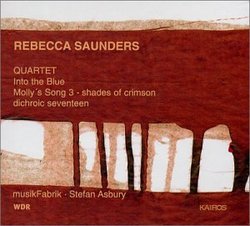| All Artists: Rebecca Saunders, Stefan Asbury, Musikfabrik Nordrhein-Westfalen Title: Rebecca Saunders Members Wishing: 1 Total Copies: 0 Label: Kairos Release Date: 2/26/2002 Genre: Classical Styles: Chamber Music, Historical Periods, Classical (c.1770-1830), Modern, 20th, & 21st Century, Instruments, Electronic Number of Discs: 1 SwapaCD Credits: 1 UPC: 782124121822 |
Search - Rebecca Saunders, Stefan Asbury, Musikfabrik Nordrhein-Westfalen :: Rebecca Saunders
 | Rebecca Saunders, Stefan Asbury, Musikfabrik Nordrhein-Westfalen Rebecca Saunders Genre: Classical
|
Larger Image |
CD Details |
CD ReviewsRemarkable soundscapes of extended techniques with an engagi Christopher Culver | 05/30/2010 (5 out of 5 stars) "This Kairos release from 2003 is one of the few CDs dedicated to the music of Rebecca Saunders, an English composer long resident in Germany. Her music mainly continues the recent Germanic modernist tradition with its delight in individual gestures and unusual sonorities in lieu of traditional melody and harmony, but as much as one can draw comparisons to Lachenmann, late-1980s Rihm and Neuwirth, this composer has quite an individual voice. Most readily apparent is her synaesthesia, with three of the four pieces here named for individual colours or (as in the case of "dichroic") colour phenomena.
"Into the Blue" for clarinet, bassoon, piano, percussion, cello and double-bass (1995) is a fine introduction. As it opens, a percussive sound is juxtaposed with a long ascending interval. This same encounter plays out with ever more elaborate variations. There appear some ethereal tones from the double bass in this piece. In fact, Saunders writes especially interesting material for the lower strings, and for me the most memorable part of "Molly's Song 3 -- shades of crimson" (1995-1996) is its anguished viola line. Steel-stringed acoustic guitar and flute provide what sounds like accompaniment, sometimes stabbing and sometimes sustained. The sudden activation of four radios and a music box playing Johann Strauss' "Emperor's Waltz" provides a surprisingly poignant ending to the work. In "Dichroic Seventeen" for accordion, electric guitar, piano, 2 percussionists and 2 double basses (1998), Saunders again incorporates an objet trouvee, the play-out groove of a record. The writing for accordion is wacky as well, more the sheen of electronics than the old-time folk instrument. But in this piece and the "QUARTET" for accordion, clarinet, piano and double bass (1998), the novelty of the individual sound events take a back seat to the dramatic interaction between the parts, and the almost Varesian agression. All in all, I think fans of the avant-garde would do well to get acquainted with Saunders' music. Kairos' liner notes are quite informative, containing an essay on Saunders' aesthetic by Michael Struck-Schloen, a sketch of "QUARTET" and the programme note for "Molly's Song 3". These are live recordings and there is some isolated coughing, but in general the disc captures Saunders' remarkable sonorities in fine sound. The German ensemble musikFabrik are prominent supporters of Saunders' music. There's also a recent Wergo disc entitled "Stirrings Still" with the group performing four Saunders pieces, and though unavailable in the US, it can be had from Amazon's UK site." |

 Track Listings (4) - Disc #1
Track Listings (4) - Disc #1